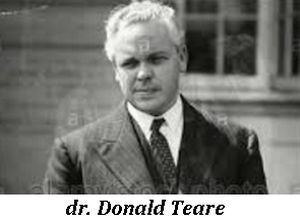Name Donald Teare | ||
 | ||
Born 1 July 1911 (age 67) Died 17 January 1979 (aged 67) | ||
Robert Donald Teare, FRCP, FRCPath (1 July 1911 – 17 January 1979) was a senior British pathologist.
Contents
Early life
Teare was born 1 July 1911, and educated at King William's College on the Isle of Man, and Gonville and Caius College, Cambridge. He trained at St George's Hospital, London, from where he qualified in 1936.
Career

Teare began his career as a lecturer in forensic medicine at St Bartholomew's Hospital Medical College. In 1963 he became reader and eventually professor of forensic medicine at Charing Cross Hospital Medical School, a post he held until retirement in 1975. Teare was also a lecturer at the Metropolitan Police College, Hendon, and served as President of the Medical Defence Union. He was a Fellow of the Royal College of Physicians and of the Royal College of Pathologists, and served as President of the British Association of Forensic Medicine.
Teare published the first modern description of hypertrophic cardiomyopathy in 1958. Today this disease is considered the leading cause of sudden cardiac death in young athletes.
In 1973, Teare carried out the autopsy on Bruce Lee, as well as Jimi Hendrix's in 1970. Teare supervised the autopsy of Brian Epstein in 1967.
Together with Keith Simpson and Francis Camps, Teare was one of the "Three Musketeers", who dealt with almost all the suspicious deaths in the London area. He was called to give evidence in many high-profile criminal investigations, such as the murder of Beryl Evans and her baby Geraldine in the Timothy Evans case. Teare's accident investigations included the Harrow and Wealdstone rail crash, which killed 112 people in 1952.
Teare retired in 1975 and died 17 January 1979 on the Isle of Man, at the age of 67.
